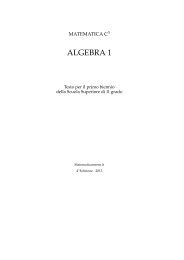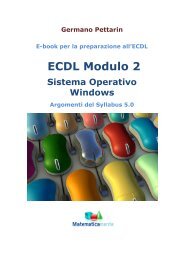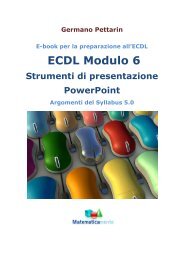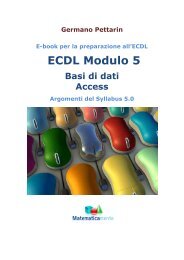1. NUMERI - shop - Matematicamente.it
1. NUMERI - shop - Matematicamente.it
1. NUMERI - shop - Matematicamente.it
You also want an ePaper? Increase the reach of your titles
YUMPU automatically turns print PDFs into web optimized ePapers that Google loves.
www.matematicamente.<strong>it</strong> - Matematica C3 – Algebra 1 – <strong>1.</strong> Numeri<br />
Scr<strong>it</strong>tura di un numero in una base qualsiasi<br />
Il procedimento usato per scrivere un numero in base 10 può essere usato per scrivere un numero in una base<br />
qualsiasi.<br />
Esempio<br />
Contare 29 oggetti in base 5.<br />
Come nel caso della numerazione in base 10,<br />
utilizziamo un abaco.<br />
Invece di contare per dieci proviamo a contare per<br />
cinque. Invece di raggruppare per un<strong>it</strong>à, decine,<br />
decine di decine e così via, conteremo raggruppando<br />
per un<strong>it</strong>à, per cinquine, per cinquine di cinquine e<br />
così via.<br />
Il numero che otteniamo si scrive 104 5 e si legge<br />
“uno-zero-quattro in base cinque” per distinguerlo<br />
da centoquattro scr<strong>it</strong>to in base 10.<br />
Per ottenere il numero decimale che corrisponde al numero scr<strong>it</strong>to in base 5 occorre sviluppare il numero in<br />
base 5 nella sua scr<strong>it</strong>tura polinomiale: 104 3 = 1⋅5 2 0⋅5 1 4⋅5 0 = 25 0 4 = 29 10<br />
Esempio<br />
Contare 29 oggetti in base 3.<br />
Questa volta dobbiamo contare per tre.<br />
Il numero che otteniamo si scrive 1002 3 e si<br />
legge “uno-zero-zero-due in base tre” per distinguerlo<br />
da milledue scr<strong>it</strong>to in base 10.<br />
Per ottenere il numero decimale che corrisponde al<br />
numero scr<strong>it</strong>to in base 3 occorre sviluppare il numero<br />
in base 3 nella sua scr<strong>it</strong>tura polinomiale.<br />
1002 3 = 1⋅3 3 0⋅3 2 0⋅3 1 2⋅5 0 = 27 0 0 2 = 29 10<br />
Riflettiamo su quanto abbiamo fatto negli esempi precedenti: i simboli che occorrono per scrivere un numero<br />
in base 10 sono dieci: {0,1,2,3,4,5,6,7,8,9} ; i simboli necessari per scrivere un numero in base 5 sono<br />
cinque: {0,1,2,3,4} ; i simboli necessari per scrivere un numero in base 3 sono tre: {0,1,2} .<br />
Analogamente i simboli che serviranno per scrivere un numero in base 2 sono due {0,1} . Possiamo<br />
generalizzare e dire che i simboli necessari per scrivere un numero in una base B qualsiasi sono B e<br />
precisamente {0,1 , , B−1}<br />
Possiamo scrivere i numeri anche in una base superiore a 10. Una base molto usata nell'informatica, insieme<br />
alla base 2, è la base esadecimale: cioè la base 16.<br />
In questo caso, per contare devo fare raggruppamenti di 16. Sono necessari perciò 16 simboli per indicare<br />
questi raggruppamenti, pertanto occorrono simboli anche per i numeri 10 , 11, 12, 13, 14, 15...<br />
I simboli convenzionalmente usati sono i seguenti:<br />
A 16<br />
= 10 10<br />
; B 16<br />
= 11 10<br />
; C 16<br />
= 12 10<br />
; D 16<br />
= 13 10<br />
; E 16<br />
= 14 10<br />
; F 16<br />
= 15 10<br />
I numeri seguenti sono<br />
10 16<br />
= 16 10<br />
; 11 16<br />
= 17 10<br />
; 12 16<br />
= 18 10<br />
; 13 16<br />
= 19 10<br />
; 14 16<br />
= 20 10<br />
; 15 16<br />
= 21 10<br />
Convertire un numero da una base diversa da 10 a base 10<br />
Per scrivere un numero da una base diversa da 10 a base 10 bisogna sviluppare il numero nella sua forma<br />
polinomiale.<br />
Se x B è un numero qualsiasi scr<strong>it</strong>to nella base B e se a n<br />
a n−1<br />
a 2<br />
a 1<br />
a 0 sono le cifre del numero<br />
da 0 a B−1 avremo:<br />
x 10 = a n ⋅B n a n−1 ⋅B n−1 a 2 ⋅B 2 a 1 ⋅B 1 a 0 ⋅B 0<br />
87
















